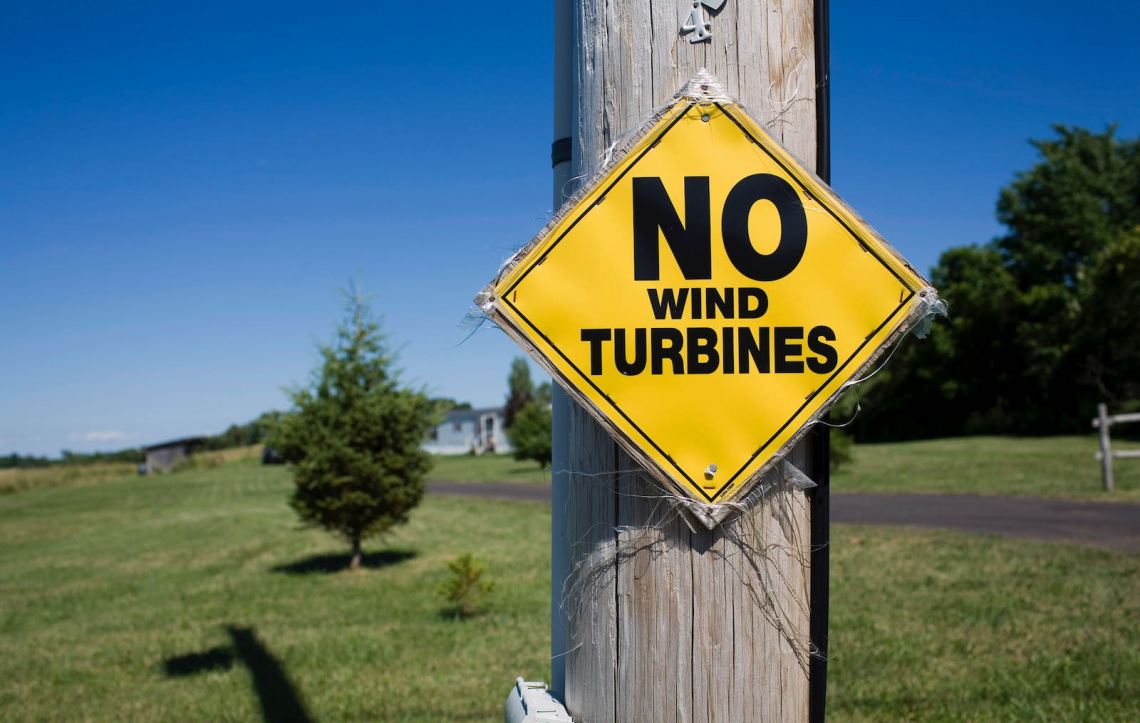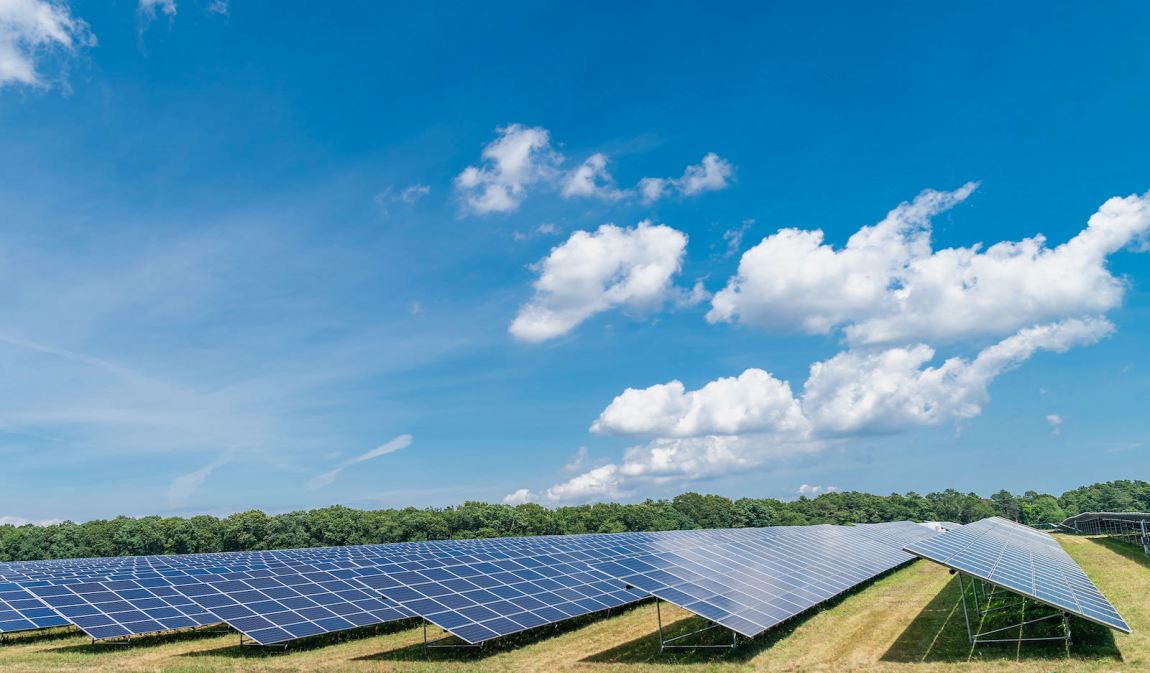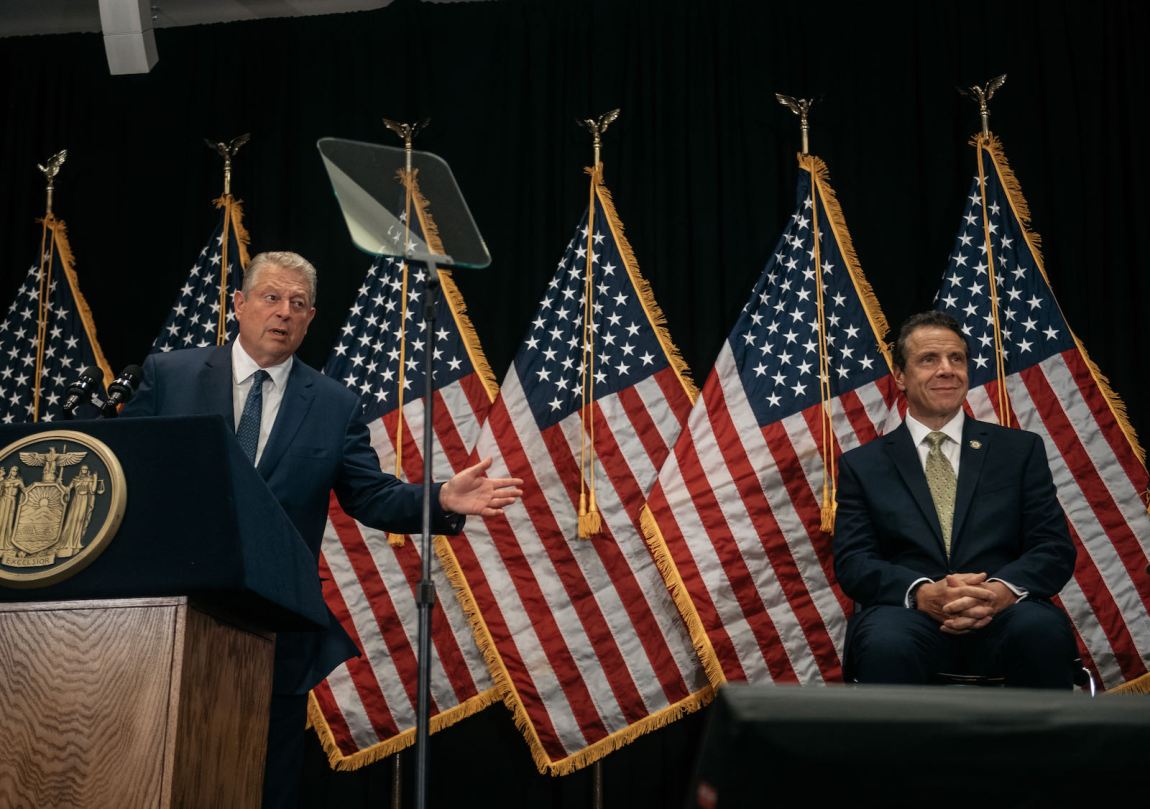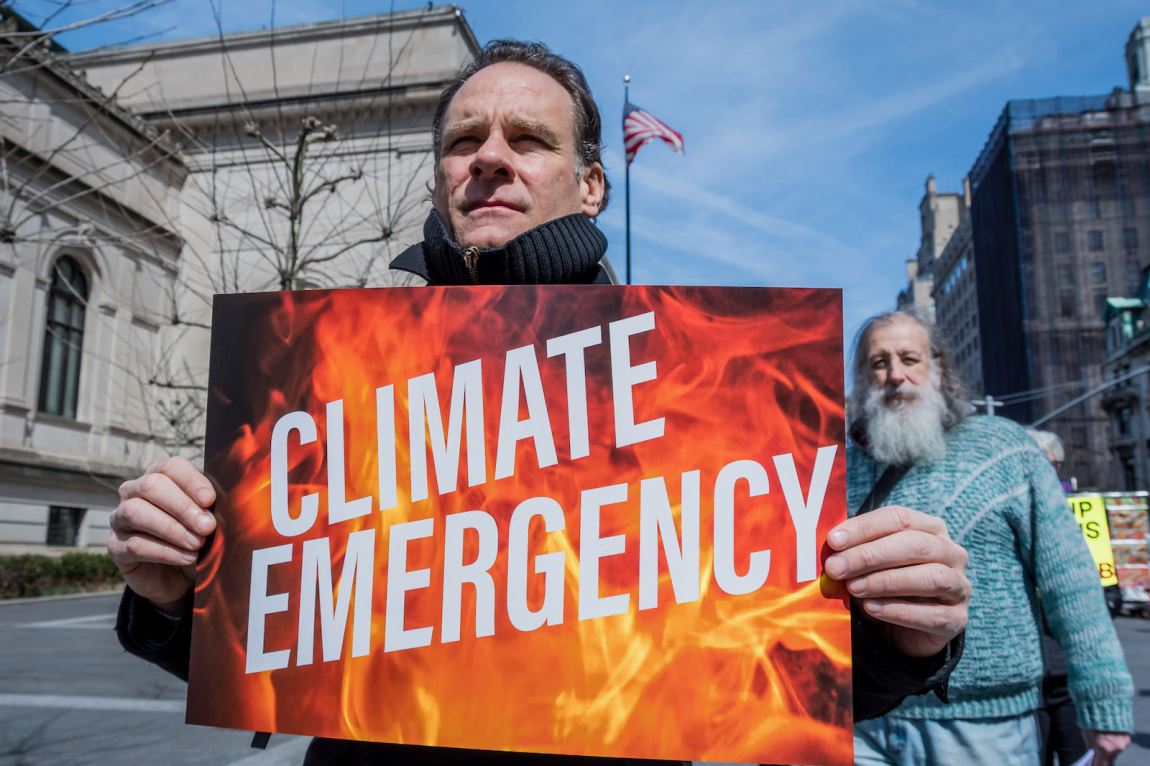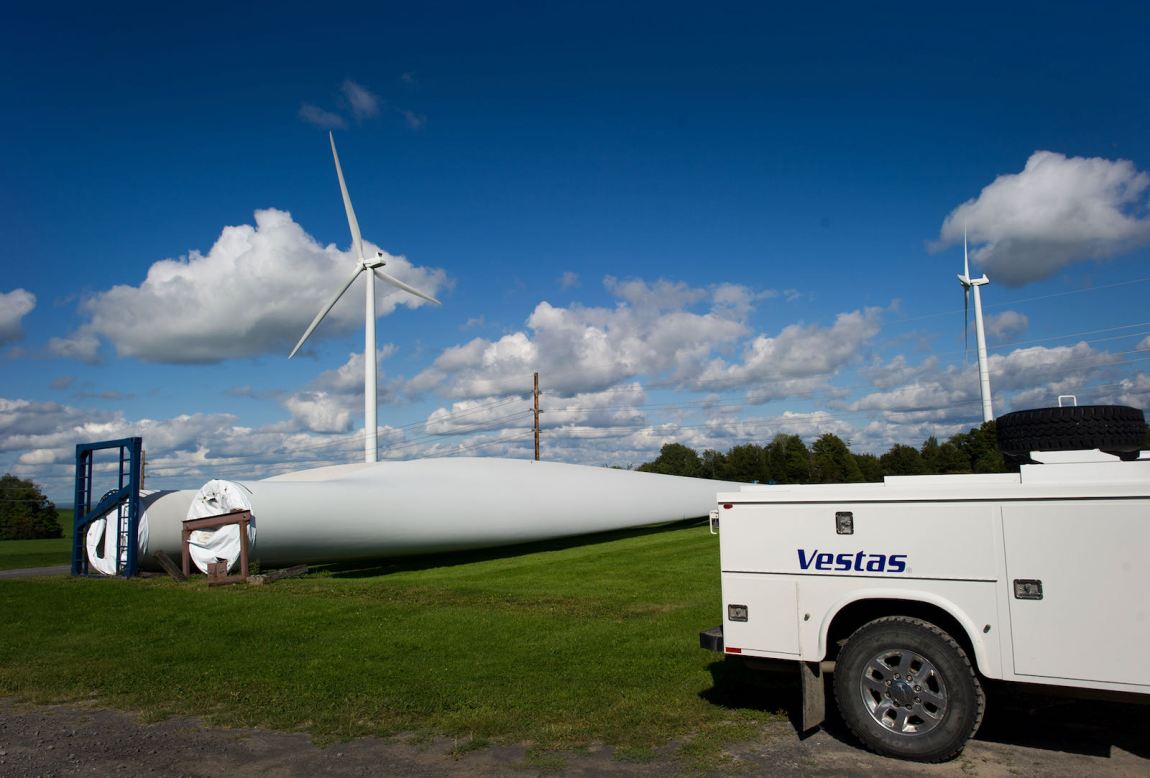Lockport, New York—On a cold evening in November last year (when we still held such large gatherings), more than two hundred people crowded into a fire department meeting hall in rural Gasport, New York, to listen to a man named Charlie Fendt speak about the dangers of solar power. An emergency management consultant from Rochester, Fendt has positioned himself as a fierce critic of solar projects before audiences in small communities like these, and his warnings that night were dire.
He told his listeners that the electrical storage batteries required on large solar fields carried the explosive risk of a large bomb. Terrorists might even strike the batteries with attack drones to set them off. If the panels caught fire, he warned, they would release dangerous toxic fumes into the air. He also told worried farmers that the same hailstorms capable of shredding a whole crop of apples in minutes could also pummel the glass panels into broken shards that would leave the land unplantable far into the future.
For a community debating a proposed two-thousand-acre solar project, these charges only further inflamed local skepticism.
A twenty-minute drive north, in the small town of Barker on New York’s Lake Ontario, sits the now-shuttered Kintigh Generating Station. The coal-powered electrical plant went into service in 1984; last spring, it was shut down under new state rules that were championed by downstate environmental groups.
Kintigh was one of New York’s last two coal-fired electrical plants. The Sierra Club boasted that Kintigh’s closing would be “a critical step in moving New York away from fossil fuels and fossil fuel infrastructure and ramping up on renewable energy.” For the people of Barker, the closure meant the end of forty-four good-paying jobs and a new hole in the local schools budget.
“This plant is my life,” Darlene Lutz told a visiting New York Times reporter. At sixty years of age, she was the first and only woman to work as an operating-room engineer there. Other Barker residents have told me that it felt as if their community had been gutted. The closure, however, had more symbolism than substance: by the end, thanks to the cheaper cost of producing electricity with natural gas, the plant was actually only producing power for about twenty-five days per year.
But the downstate environmental groups offered up an alternative economic plan for the people of Barker, in the form of forty-five giant wind turbines to be erected over the small villages that dot the lakeshore. Each one would be taller than the Washington Monument. Community opposition was fierce. The citizens’ group that organized to fight the project warned of noise pollution, the threat to migrating birds, the impact of giant tower lights on their dark rural skies, and other effects they said would alter their communities in profound ways. They also noted that, once construction was done, the project would create no lasting jobs, little in the way of new revenue, and would mainly deliver big profits for the scheme’s corporate owners in Virginia.
Niagara County, that small corner of western New York known primarily for its mammoth waterfall, has now become something else: a battleground in the nation’s effort to transition our energy production away from fossil fuels and toward sources like solar and wind that are essential to stave off the worst impacts of global climate change. That rebellion, mirrored elsewhere in the nation, is a cautionary tale about the potential for a widespread backlash that the push for sustainable energy can ill-afford—but one that can be avoided, if we pay attention.
There is a good reason why this part of New York is a target for wind and solar development. Energy developers told me that it possesses the three ingredients they need most: open land, landowners willing to lease it, and close access to high-capacity power transmission cables. This includes the cables that were installed to carry energy produced by the now-closed coal plant and the mammoth US hydroelectric facility at Niagara Falls (which produces enough electricity to power more than two million homes).
But in a county where most local towns have populations of fewer than five thousand residents, people here know that all this large-scale energy production is really about generating power for those who live elsewhere. Many western New Yorkers (people here are quick to remind you that this is not “upstate”) already harbor deep resentment toward New York City, for its political habit of dictating things for everyone else. Many here see the push for industrial-scale renewable energy as a scheme mainly to keep the lights on in Times Square.
*
The proposed Ridge View solar field, the project that packed the fire hall last November, would be one of the ten largest solar fields in the US if it is built. It would spread solar panels across forty different farms, and would cover an area equal in size to fifteen hundred NFL football fields. The proposal has split the tight-knit communities here.
Advertisement
The dramatic-sounding safety issues raised at last November’s town hall are overblown. While there have been isolated incidents of industrial-size batteries catching fire (but not of blowing up like a bomb), they are rare, and the evidence suggests that this has to do with a handful of manufacturing errors rather than any inherent danger of the technology itself. The warnings about solar arrays being unable to withstand hailstorms are pure myth. What is real, however, is the divided opinion over whether giant, industrial-scale solar projects belong in agricultural communities like these. I spoke to two local farmers with very different views.
Mindy Vizcarra is the owner of Becker Farms, a beautiful 340-acre spread that offers everything from pick-your-own apples in the fall, to a venue for weddings, to a small pub where my family has gone to hear music by local artists. Mindy is a supporter of the Ridge View solar project, and her farm is one of those slated to be a part of it. She explained to me that a fifty-acre plot of her farm, which she currently rents out for $80 an acre per year to someone who grows grass for hay, would be leased instead for $1,000 an acre per year for the solar project. She says the array would be in the middle of her land, closed off behind a chain-link fence and shielded from view by trees, bushes, and a berm.
Because the full project would be spread out across many farms, Mindy says, “It’s not really as much land as you think. It’s not going to change things as much as people think it’s going to change things.” In Becker Farms’ case, she says, the area around the solar panels would be planted with native wildflowers to create new pollinating lands for the threatened bee population. Advocates of these projects say that they offer a way for farmers to diversify their business and to remain economically viable even in years when their crops may suffer. Mindy also sees the project as an opportunity to contribute to a cleaner energy future: “We are taking a stand and being a part of the solution.”
Down the road, in the town of Middleport, Margaret Darroch’s small farm raises animals and produce, and has a thriving small bakery. She says that her hesitations about Ridge View began with what she says were serious misrepresentations to the community by the company. “They told us that it was just 10 percent of our agricultural land. It’s 27 percent of our agricultural land,” she noted. “Nobody is against solar. It’s the size.”
Margaret says that the huge project, which would involve two years of heavy construction, would have a major impact on the land that this part of the state relies on for its agriculture. “You can’t just drive big equipment and put up concrete blocks on top of soil and have it be okay,” she says. “To take such a rich area and use it for this purpose makes no sense to me.” Others here have questioned what will become of all those fields of glass and steel decades down the road, when their productive life ends and the solar companies move on.
*
Ridge View is just one of several large solar projects being pushed in the county, with other companies knocking on the door as well. The push for all this development is closely tied to Governor Andrew Cuomo’s plan to have 50 percent of all electricity in the state produced from renewable sources (solar, wind, hydropower, and biomass) by 2030. Just ten years away, it is an ambitious goal that state energy officials hope to meet with industrial-scale projects like those proposed here.
The driving force behind these projects is more than politics, however; it’s economics. For the companies involved, these are lucrative prospects thanks in part to heavy subsidies from federal and state taxpayers. But rural communities are starting to pose some hard questions about why they are being asked to add huge tax breaks of their own for renewable energy projects that offer few local benefits.
A much smaller-scale solar program proposed in Lockport, the city where I live, provides a good illustration. OYA Solar, a Toronto-based company, is seeking a change in the city’s zoning rules to allow it to construct a 24,000-panel system across forty-seven acres of farmland. The project would generate enough electricity to power about 1,450 homes. It is also classified as a “community solar” project, which means two things: that it is small-scale and that it will sell its electricity to local households at a price about 10 percent lower than the local utility company charges.
Advertisement
For the company, the solar field would be an investment of about $11 million, with nearly half of that paid for with $5 million in federal and state tax subsidies. OYA says that the value of its annual electricity production would be just shy of $1 million per year. Using New York State’s suggested valuation formula for solar fields and applying the same local property tax rates that local homeowners and businesses pay, the company’s annual tax bill would be $143,000 per year, split between three different local governments. But the company is seeking an arrangement known as a Payment In Lieu of Taxes (PILOT), under which its annual bill would instead be just $35,000. The City of Lockport’s share would be about $12,000, roughly the cost of putting on its annual twenty-minute July 4 fireworks show.
When that same math is applied to a megaproject like Ridge View, which would be nearly fifty times larger than the OYA solar field, the local tax break figures become enormous. Its owners calculate its construction cost at nearly $400 million. The company won’t say precisely what it is expecting in subsidies, but the federal tax break alone should be worth more than $100 million, with more to come from New York State. If the project were taxed at the standard local property tax rate, its annual bill would be just over $6.5 million. But again, the company plans to push for an annual PILOT flat payment of about $1 million, split between a whole range of local governmental bodies and school districts. That’s a local tax break of more than 80 percent.
All this raises an important issue that goes far beyond western New York: Why is Big Solar’s business model dependent on communities’ forgoing millions of dollars in property tax revenue, critical for local services, for projects already so heavily underwritten by state and federal tax dollars?
PILOT arrangements are standard fare in much of New York, a public finance recipe that usually goes like this: a company—say, Amazon—comes to town and promises that its project will produce numerous jobs and other economic benefits. To entice this development the local government pledges to cut the company’s local tax bill, though supposedly still leaving local coffers well ahead of where they would have been if the company hadn’t come to town. In practice, however, localities are often driven into a race to the bottom against other communities, cutting their tax take as low as they dare in order to hold on to the project, with what are routinely exaggerated spinoff benefits.
But, as flawed as that logic often is, it doesn’t hold at all for solar projects. Acres and acres of solar panels generate no lasting local jobs, except for maybe a few people who come around to keep the weeds down. The profits these solar farms make are all pulled out of the community and sent to corporate headquarters and shareholders far away, often out of the country.
Public officials in small, struggling communities like these are often so hungry for any prospect of economic development that they will scramble, even for crumbs. At an October meeting of the city council in Lockport, the city’s mayor raised concerns about OYA’s ask for a giant tax break. In reply, some local aldermen warned that demanding anything more than even the $12,000 offered might jeopardize the chances of securing even that. The city’s annual budget is about $25 million.
Hovering in the background of all this are the pressures from New York State to get these projects built. Last April, state lawmakers moved that pressure up a notch with the Accelerated Renewable Energy Growth and Community Benefit Act. It includes new limits on the powers of local communities to stand in the way of industrial-scale renewable energy projects. Backed by Governor Cuomo and environmental groups, the new law allows the state to identify potential sites and fast-track them through the permitting process. It gives state officials the power to override local zoning laws, and it inserts the state into negotiations between local governments and the renewable energy industry over how much corporations should be required to pay in local taxes. The act’s critics have called it a complete evisceration of home rule that would put all the power into the hands of distant bureaucrats racing to meet state energy targets.
*
I’m a fan of solar power. I take joy in the fact that every time I head down to the basement to do a load of laundry, 100 percent of the energy comes from the fourteen solar panels we had installed on our roof last year. And as the father of a teenager, and the grandfather of two little girls, I am deeply concerned about how climate change will alter their futures—I am keenly conscious of the urgent need to move away from fossil fuels. I have also been a climate activist, in the US and abroad, for many years. Nonetheless, as I have looked up close at how these industrial-scale projects are being pushed in western New York, I feel an uncomfortable sense of déjà vu.
During the two decades I lived in Latin America, I worked side by side with local communities fending off the abuses of foreign corporations. Last year, I wrote a report titled Manipulative Ways about the playbook that global conglomerates use in countries like Bolivia, Peru, and Colombia to seize control of their water, minerals, and land. Their initial two moves are always the same: first, they wrap themselves in the language of development and declare that they are really there to make the country better; second, they make sure that any levers of democracy that might get in their way are set in their favor, especially if it seems like local communities might rebel.
My other feeling of déjà vu comes from the years that my family lived in San Francisco at the start of the tech boom. In a place where the local political culture is generally deeply skeptical of corporate power, companies like Facebook, Twitter, Google, and Apple were considered different: they were cool, they were the good guys—until people realized that they were corporations like all the others, with business models ever ready to sacrifice the public good if a profit could be maximized.
In the climate movement’s hearty embrace of the wind and solar industry, we would do well to remember that these are also corporations, often using that same playbook. They talk a good game about how communities will benefit and how any impacts will be minimal. Then, just in case that argument doesn’t carry the day, they have state energy officials and other political allies waiting in the wings to clear the way.
The transition to sustainable, renewable energy in the US is a matter of planetary survival. But it is not only the energy that needs to be sustainable; the politics of that transition need to be so, as well. If the Trump era has taught us anything, it is about the perils of provoking a popular backlash in communities like these. In fact, we are squandering the chance to build powerful alliances with them. To do this, I would propose three vital principles.
First, as much as possible, large-scale energy production projects like these should be targeted for siting on contaminated brownfields, before agricultural land. Niagara County, unfortunately, has more than its share of contaminated land, the remnants of reckless industries going back a century: Love Canal, the notorious toxic landfill, is here. Before we take huge tracts of farm land out of production for forty years or longer (land that climate change itself may make more necessary for growing food), we should first put solar fields on land that contamination has rendered useless. That would win wide popular support here and also convert brownfield sites into an engine for clean energy.
Second, the local communities need to be involved as genuine partners and beneficiaries of the wealth these projects create. Companies that want to build solar fields worth hundreds of millions of dollars, already much-subsidized by taxpayers, should not be waltzing into small towns demanding colossal tax breaks on top. They should pay their fair share—and they should pay it in electricity.
Let the solar company that wants to locate here in Lockport pay its taxes by lighting up our high school with solar power. Let the company that wants to put solar panels across 2,000 acres of rural fields pay its taxes with solar-powered town halls and elementary schools. That would create direct savings that local governments can use either to cut property taxes or to expand services. This would take communities that are worried about being losers from clean energy production and turn them into clear winners. Their solar power will become a thing of local pride, and the companies involved would be getting a retail-priced tax credit for what that costs them only a wholesale rate to deliver.
Lastly, we need to let communities like this decide what scale of power project works for them. A vision imposed from elsewhere is both unfair and will always meet resistance. Downstate, in New York City, there are plenty of climate activists who understand this. Nancy Romer is chair of the Environmental Justice Working Group of the union that represents 30,000 faculty and staff at the City University of New York. “Climate justice activists here don’t want long-distance solar, wind, or hydropower coming from upstate to downstate,” she told me. “Downstate can get their own energy through offshore wind and local solar if we step up and invest in those things.”
Unfortunately, not everyone of a green power mind is especially interested in how rural communities are affected by energy transition. When, back in March, The New York Times published a feature on the closure of Barker’s coal plant, some of commenters’ posts rang with a callous condescension that distance allows—“I’m sure the people employed by the last buggy whip factory, or saddle makers, or sail makers, etc. were sad when their factories closed and lost jobs,” read one such comment. “What I do find sad, is the low level of education and openness to new ideas and concepts of the residents.”
As urgent as it is that we move swiftly to power production that will not overheat the planet, that imperative does not grant license to tell the communities involved to suck it up and cope for the greater good. We need to listen, think more creatively, and chart a path forward we might all walk together.


